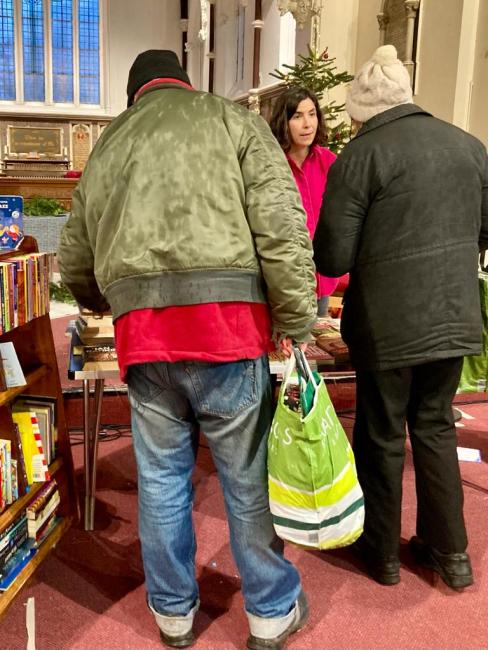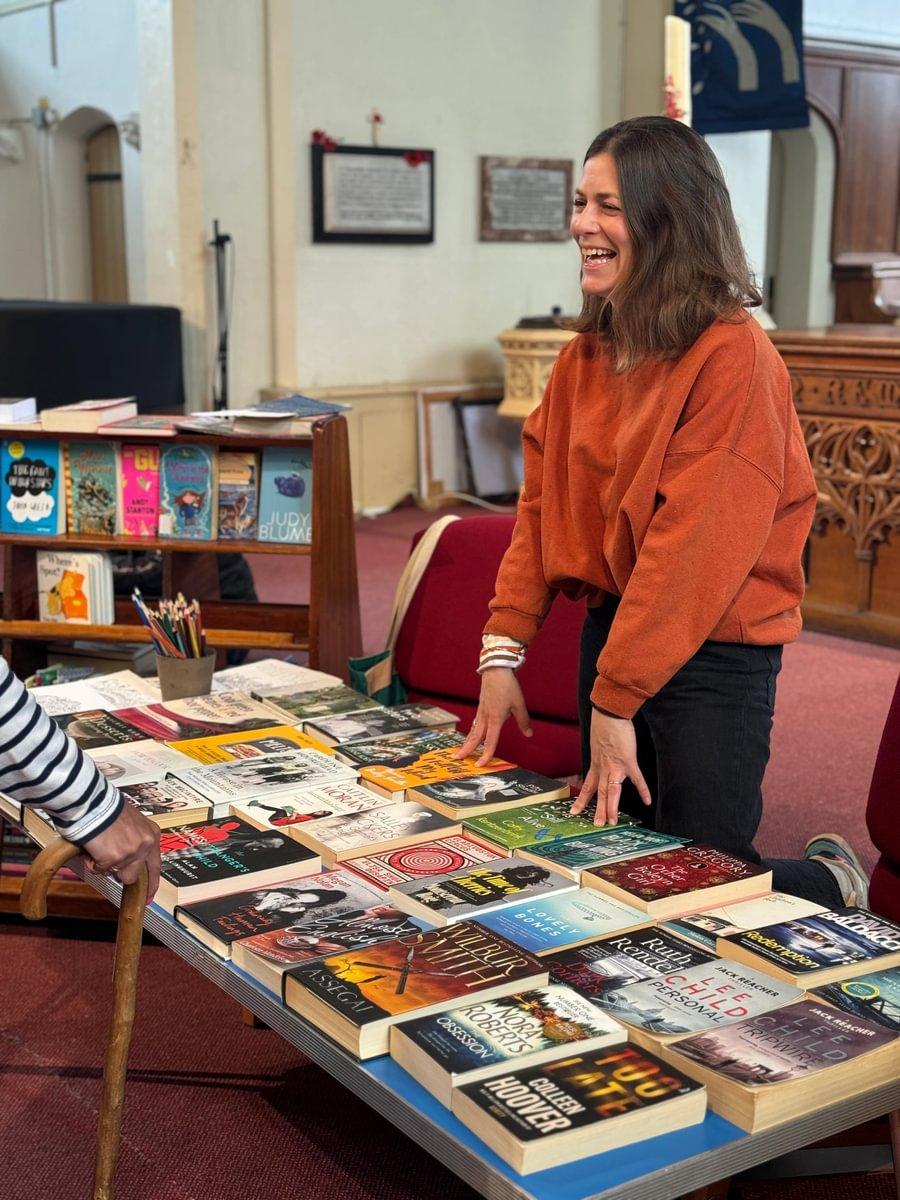Reading is really beneficial, but a wide range of social and monetary factors prevent many from enjoying the benefits. However, there is something that your church can do to help. Mildmay St Jude & St Paul’s Church, in North London, created a Book Bank to run alongside its food bank. Now, people can access a wide range of books for free, which has led to more people in the area able to enjoy reading and talking about books, which has also created a strong sense of community within the church building.
Find out below how the book bank was established and how the church has embraced it. Plus, get advice for how you can set up your own book bank.
A plan for change: how it all started
The book bank originated from a food bank, which the church set up during the Covid-19 pandemic.
“Children in Islington get free school lunches, but obviously during the summer that doesn’t happen,” explains Revd. James Hill, Vicar at St Jude & St Paul’s.
“We said ‘let’s open our doors and we’ll just do a very simple kind of food bank for anyone that might need some extra food at this time’. It was just going to be a pop-up food bank for one month and then shut. It ended up going into three months because the needs grew and then the cost-of-living crisis hit."
“It was at that point then the Newington Green Action Group then asked if we could store some extra food for them.”
Over time, the food bank became a long-term part of the church’s activity. It grew and is now attended by more than 100 people each week.
Despite the success, the food bank project took another turn when one volunteer had an idea for change during the summer of 2022.
Emily Rhodes, who has gone on to become Founding Director of the charity Bookbanks, explains how the idea for a book bank first came to her:
“I’d spent my entire life working with books, whether that was as a bookseller, as a book reviewer, as the host of a book club... I worked in publishing before that. So, I was coming into the food bank and the church completely from the book world."
“When I came into the food bank that day in June, I noticed it was an incredibly beautiful space. But there was this silence, and it felt quite fragmented, and people were sitting there waiting for their food order.”
“I just thought, why don’t we bring books in and see what it’s like?”

Instant impact
When the church put the plan into action, it didn’t take long to get up and running.
“I think it was [within] about six weeks, maybe a month, we’d amassed about 300 books. So very quickly these book donations came in. And I just gave it a go one day in September. I put out a trestle table, which the church provided, and made a display,” explains Emily.
“I made the display according to theme and genre. What was really noticeable was that immediately everybody flocked to this table. It became a real focal point.”
It was clear that the book bank was an immediate success. People accessing the food bank were taking the books and also talking about the books.
“These conversations were immediately going off into quite a lot of different directions. So, they might talk about their children’s love of reading...or they might share a beautiful memory about how their father used to read to them,” Emily says.
“We’re giving out masses of books. We’re literally putting books into the hands of people who would otherwise struggle to afford them. And these are books that were theirs to keep. You know, they never had to return them.”
“The books had done something to the atmosphere and to the experience of accessing a food bank. It was no longer just about getting food. It was also a chance to chat and a chance to be inspired and a chance to access a different part of your brain, where you’re not really thinking about the absolute necessities of whether this week you need rice or pasta.”
James expands on this point:
“It’s really brought a new dimension into what we do and what we offer because it’s not really transactional.”
“It offers that open space...something else is happening where people are finding friendships, they’re making connections, which the book bank is helping with.”
The book bank in St Jude & St Paul’s proved so successful that Emily set up the charity Bookbanks, and has expanded into six sites across the UK, including five churches.
Why the church is a perfect setting
While the scheme has been a great success as a piece of community outreach, it has also brought people into the historic church building.
“A church is a particular place where some people find it easier to pray, but some people like to experience the atmosphere. It brings a different dimension to if we were doing at the library, and it brings different conversations,” shares James.
“There have been quite a lot of people coming into the church through book banks, who wouldn’t normally,” Emily adds.
“[for instance] People come along because they’ve heard about a writing workshop. They didn’t even know about the food bank or the church. Most people do come for the food. But some are coming for the books, and they’re always amazed by the space, the beautiful church.”

Volunteers are crucial
The Mildmay St Jude & St Paul’s book bank has been really impactful for the local community. But projects like this require dedication and, like any project, wasn't without its challenges, which Emily encourages churches to think about.
One of the biggest was resourcing the stall. Emily quickly identified that the food bank volunteers already had a lot to do.
“It felt like an extra task for them. I felt like a need to either be there every week, or to create a separate team of volunteers that came from the ‘book world’,” she explains.
So, Emily worked hard to recruit volunteers with a background in books, including writers, publishers, literary agents, librarians and more.
Now?
“We have a team of eight volunteers per site, and we ask them to do just one shift a month,” she explains.
“We actually have a waiting list for volunteers now at all our sites!”
Creating something valuable for the community
It’s wonderful to make a difference with a food bank or book bank, but there are always some running costs to bear in mind and it’s worth having an idea of these before getting started with a community project. The volume of work can grow very quickly. So, it’s important to make sure you have enough resources to manage it.
For example, you may have to pay some volunteer expenses, print posters to advertise the Book Bank, and have storage space for the books, table and displays.
“It’s very similar to running a church. You have to have the right documentation and do things in the right way,” explains James
“The image I use more and more is the vineyard. You have the vine growing with the grapes. But behind the vine is the trellis. And you have to have that background stuff – the policies and risk assessments.”
By setting up a book bank, St Jude & St Paul’s Church has added a new dimension to its space as a community hub. People are now able to enjoy stories, learning and sharing from books. Through a combination of hard work and open-mindedness, they have created something so valuable for the community.
For churches: top tips for your place of worship
-
Think about how a Book Bank can work alongside the community work you’re already doing. For example, when your food bank or youth groups are running.
-
Volunteers are essential. When launching a new project, it’s important to make sure you have enough volunteers with the right skills to make it a success. Think about what task they will need to do and then recruit with that in mind if you need more. Advertising for volunteers on social media is a great way to reach new people. Make sure to communicate why you’re wanting to set up the space – people are more likely to sign up and volunteer if they understand the problem and the impact you're wanting to make. You can read more advice on recruiting volunteers here.
-
Don’t underestimate the resources you will need. Ensuring that any community projects you’re running are sustainable is a key consideration. Costs can appear from all sorts of unexpected places, so having enough budget allocated for contingency is important, as well as thinking through storage solutions.

